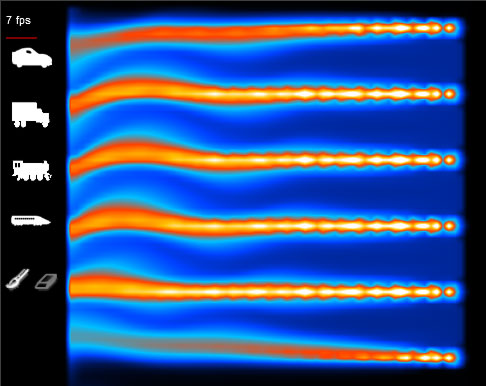What's new
Subscribe to our RSS feed
3rd December 2008
Wind tunnel
There’s something very seductive about the movement of fluids. Whether it’s water in a stream, or smoke rising from a fire the patterns are similar and beautiful in their complexity. We’ve been doing some experimentation and managed to create a fully functional simulation of a wind tunnel. You can choose different vehicles and see how they perform or use the brush and draw your own streamlined shape. To do this we’ve had to solve the Navier-Stokes equation which until recently was the preserve of dedicated high power computers. These days however, you can try it yourself if you’ve got a recent multi-processor PC. Go on, give it a go.


Very nice. I’d be very interested if you could share any insights on Navier-Stokes approach you took for the simulation?
Glad you like it. It’s based on the Jos Stam’s paper “Real-Time Fluid Dynamics for Games”. Which is available at: http://www.dgp.toronto.edu/people/stam/reality/Research/pdf/GDC03.pdf
I think this game is great – the real-time interactivity makes the tricky business of computational fluid dynamics much easier to grasp for younger audiences. We’d love to use something like this to demonstrate our work here at Swansea University on the BLOODHOUND SSC supersonic car.
Very nice indeed. I noticed that there kind of 6 channels (cars, trains etc.etc.) so I was wondering whether you are using some kind of parallelism in the code for each channel, or you are doing each sequentially?
We, during christmas tried the PB Api on on some timeseries for stocks, having the PB-api calculate volatility of a stock.
Worked fine, but the speed increase we were looking for were only gained in form that the main Flex-thread was offloaded during the calculation. Which basically means that the incentive of using this are gone.. Unless we can parallelize the algorithms.
This was the background for my question, hope for a positive response.
FYI. this is the Flex app. in question.
http://www.softcapital.com/radarlite
Cheers,
Lars
Thanks for your comment Lars.
The Fluid Dynamics algorithm works by dividing the area into thousands of tiny cells and then calculating the density and velocity of the smoke in each one. This is means that the algorithm is inherently parallel and the more processors you have on your computer the faster the simulation will run.
You’re correct in saying that you’ll need to parallelize your volatility algorithm for PB to give much of a speed increase.
How you do this will depend on the algorithm you’re using.
All the best
Joe